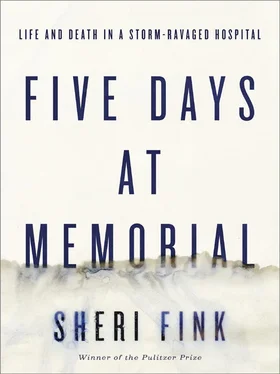The next morning, the mayor and city authorities set out for the site of the power-line accident to demand that NOPSI supply additional power to the drainage system’s plant. But the two power systems operated on different frequencies—one at 25 Hz and one at 60 Hz—and, due to the lack of an appropriate transformer, no transfer was possible. The engine of the mayor’s car failed in the rising water as he tried to leave. Marooned, he had to await assistance.
Across the city, hundreds of cars were similarly trapped, and nearly all streetcar lines had halted operations. While floodwaters gradually receded in some areas, in others they rose again as Lake Pontchartrain overtopped levees and spilled out of drainage canals that cut through the city.
Water flowed up to the stages of the city’s theaters, covered cemeteries, inundated stores, and stalled fire engines racing to respond to emergencies. City dwellers called police for help when water awakened them in their beds. Alarmed residents of one neighborhood fired gunshots into the air to attract attention. An armed band of robbers hit a series of abandoned homes by boat. Calls from “anxious mothers” poured into the Times-Picayune newspaper with “harrowing tales of suffering from lack of food and milk for children.” The mayor sent police reserves to commandeer boats and deliver aid, but they were overtaxed by the number of people in need of assistance. The newspaper declared “virtually a complete failure of city authorities to provide relief,” a charge the new mayor called “so manifestly untrue and unfair as to hardly need official notice.” He cast the blame, as he had the previous year, on the Sewerage and Water Board, whose chief engineer declared that the flooded streets were due “principally to an act of God.”
City leaders refused relief offered by the Red Cross and National Guard, arguing it was unnecessary and that accepting it would give the city “a black eye before the nation.” Impromptu ferry captains shuttled people around town in flat-bottomed pirogues. Mothers pinned up their girls’ dresses and rolled their boys’ trousers and let them wade. On Sunday, a matriarch hiked up her skirt and led her family on an Easter stroll through shin-high water as a newspaper photographer snapped a picture of them. A six-foot-long alligator swimming down a street was captured and sent to the Audubon Park Zoo.
Again came calls for action. The homeowners’ association of the hard-hit Lakeview District demanded that the levees be raised and the drainage system strengthened so that “the ‘hand of God’ will not be blamed as often for what the hand of man has neglected to do.” It called on city authorities to use their charter rights to issue emergency bonds for the work rather than await approval of a larger refinancing plan. A Times-Picayune editorial backed the plan: “We believe the people of New Orleans stand ready to pay whatever sum may be needed for reasonably adequate and efficient protection against these temporary but costly flood nuisances.”
Superintendent Earl agreed. He called for an increase in the city’s debt limit from 4 percent to 5 percent of its assessed value (a negligible change when compared with the 35 percent limit in effect at the time of Katrina). Earl also called for higher and stronger levees. His board had no responsibility for the city’s levee system, but levee failures affected his ability to drain the city. He also foresaw the rapid growth of New Orleans, as transportation companies increasingly used America’s interior waterways. He feared that as the city expanded and land that accepted Lake Pontchartrain’s occasional overflow was walled off with levees, the water level in the lake would rise.
Municipal employees spent days after the storm cleaning up debris, digging drainage ditches, picking up animal carcasses, and spraying pools of standing water with disinfectant. In much of the city, the flooding was shallow and short-lived, as the half-powered pumps gained traction.
In the area around Baptist Hospital, as well as Lakeview in the north and Gentilly in the east, the water rose for a longer time and reached a higher point than anywhere else in the city. Along Napoleon Avenue, the water rose to six feet and flooded the first floors of homes. The basement of Baptist filled with eight feet of water. For the second time in the hospital’s short history, its operations were disrupted by flooding.
The swell of water from the upper Mississippi reached Louisiana two weeks after the Good Friday storm. On orders from the State of Louisiana, workers dynamited a levee below New Orleans to relieve pressure on the levees protecting the city, sacrificing the Parishes of St. Bernard and Plaquemines to save New Orleans at the behest of the city’s business elite, who then failed to deliver promised restitution. This launched a grudge that would persist into the next century. The Mississippi River floods of 1927 led to one of the most expensive peacetime legislative initiatives of its time, the 1928 Flood Control Act. It tasked the Army Corps of Engineers with improving the levee and flood-control systems of the lower Mississippi River, giving the federal government full responsibility for the river, and granting the Corps immunity from liability for damage that might result from its work. Decades later, the Corps became more involved in flood protection projects for the city of New Orleans itself, including the drainage canals leading to Lake Pontchartrain.
Over the years and decades following the 1927 storm, the Sewerage and Water Board obtained funds to improve the New Orleans drainage system. One of its engineers designed the world’s largest pump, and fourteen of them were custom-made for the city. Drainage capacity had nearly quadrupled by the end of the twentieth century to more than 45,000 cubic feet per second.
Still, the area around Baptist Hospital in the Freret neighborhood remained the site of some of the worst flooding. The city failed to get a handle on it. Staff had to develop their own coping mechanisms. In the first years of the twenty-first century, workers knew a moderate storm could fill the streets around Memorial Medical Center with enough water that they would have to park their cars a block or so away on “neutral ground”—the high berms between lanes. Hospital maintenance men would put on waders and pull colleagues to work in a battered metal fishing boat kept suspended from the ceiling in the parking garage basement. Equipment, supplies, food, records, and linens were again stored in the basement. Many Memorial employees had long ago stopped seeing water as a significant threat.

CHAPTER 2
BEFORE THE STORM
SATURDAY, AUGUST 27, 2005
GINA ISBELL PULLED a white scrub shirt and navy-blue pants over her ample frame. The forty-year-old registered nurse had received a worrisome call at home from her boss that morning. Hurricane Katrina, revving in the Gulf of Mexico, had strengthened overnight and now had a good chance of steering into southeast Louisiana. A hurricane watch covered a wide swath of coastline. Katrina’s strength was rated Category Three on the Saffir-Simpson Hurricane Wind Scale, projected to grow to a fearsome Four or even a catastrophic Five. Meteorologists predicted landfall on Monday, with hurricane conditions possible by Sunday night.
Isbell’s home, her family, and her hospital were in St. Bernard Parish. LifeCare, the specialized hospital where Isbell served as nursing director, occupied a single-story building there in Chalmette on Virtue Street. The question was whether to move the patients somewhere safer, just in case. The risks of transporting very sick patients for a false alarm had to be weighed against the risk that floodwaters could rise over the rooftop if the forecasts were accurate.
Читать дальше













